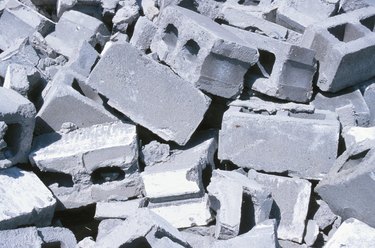
Concrete masonry units, or precast concrete blocks, harden because of hydration, a chemical reaction between Portland cement and water in a mixture that also includes sand, gravel and lime. Hydration causes cement particles to grow nodes and link together, bonding to the sand and gravel and forming concrete, according to the Portland Cement Association. Alkaline salts in the cured concrete absorb water and slowly continue the chemical reaction that hardens the block. Water the concrete collects during wet weather can freeze later on and crumble the surface of the block.
Freeze Damage
Video of the Day
Any untreated concrete can develop scaling, a flaking or crumbling of the surface layer. A concrete block's smooth face consists of a thin layer composed mostly of Portland cement and sand. Potassium and sodium salts draw water into the surface layer by capillary action that doesn't depend on open pores or faults. When the water freezes, the expanding ice pushes the outer layer away from the gravel aggregate beneath. As scaling wears away the outer layer, the process repeats and damage deepens. Severe scaling exposes the gravel in the block and if unchecked can crumble the load-bearing sections of the concrete.
Video of the Day
Chemical Damage
Improper curing techniques can cause scaling of concrete, but strict manufacturing controls ensure the initial quality of most cement blocks. Chemical contamination causes severe pitting and scaling of concrete even without freezing, but some chemical damage comes from de-icers that exaggerate freezing stresses. If de-icing chemicals used on nearby sidewalks splash onto the foundation, the salts enter the block, drawing water along with them. The next round of severe cold shatters the surface. In the summer, common fertilizers such as ammonium sulfate or ammonium nitrate broadcast on lawns and gardens can pit cement blocks if splashed onto the concrete by rain.
Preventing Damage
Most water runs off concrete, but if the foundation lacks a protective coating some moisture always moves into the block. After the mortar in a foundation fully cures, painting the foundation with a sealant prevents many future problems. Homeowners should seal the foundation during hot, dry weather when the concrete holds the least moisture. Acrylic concrete sealers paint on easily and offer long-term protection against water and chemical damage. The National Ready Mixed Concrete Association also recommends a mixture of equal parts boiled linseed oil and mineral spirits, applied in two coats. The linseed treatment contains no dangerous chemicals but will darken the concrete.
Repairing Damage
Patching scaled concrete blocks with new mortar can restore the foundation and prevent deeper damage, but repairing large areas of scaling needs a professional touch. Any sealant, dirt or weak concrete left on the damaged area weakens the new surface. Cleaning up a damaged foundation for patching calls for powerful equipment, such as pressure washers or portable sandblasters. Patching mortar or Portland cement laid expertly over the damage hardens quickly into a new surface, but the procedure requires fast, accurate work and good timing. After curing, sealing the foundation protects the patchwork and paint gives the concrete a uniform appearance.